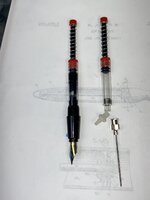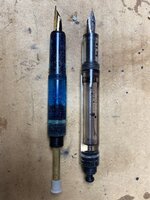Mike
Don't want to haggle over terms, but a 'piston fill' and 'plunger fill' are two names for the same generic filling principle - in either case, a plunger forces a piston into the reservoir to expel air and any remaining ink, and then when the plunger is withdrawn, the piston creates a vacuum within the reservoir that draws in ink. That mechanism can be built into the pen body (as in the case of the Noodler's Konrad where there is a small cap at the end of the body that is removed to access a twist knob), or it can be part of a removable element called a converter or pump, in which case the entire body is removed to access the knob. And while a twisting knob is the most common approach to actuating the piston/plunger, it can also be actuated by means of a slider (most often seen on inexpensive Chinese pens) or it can be a spring-loaded press-in plunger.
The fact that the piston/plunger fill principle creates a vacuum in the reservoir to draw ink into the pen can lead to confusion with another form of vacuum filling. One of the early filling mechanisms involve a small rubber sac that served as the reservoir, and a lever on the outside of the pen body that pressed a plate against the sac to expel air. Then, when the lever was released, a vacuum would be created that drew ink into the sac. A later variation on this principle was to replace the external lever with an internal sleeve around the sac - the user has to remove the pen body to press a flexible portion of this sleeve against the sac. This innovation may have first been used by Parker (I have a mid-1960's era Parker model 45 that uses this kind of fill), but it's still being used by some Asian pen makers such as Hero who specialize in Parker clones.
Syringe filling, by contrast, is a design wherein ink is injected into the pen using a syringe. An alternative (and older) name for syringe filling is eyedropper filling. This principle dates to before modern filling mechanisms were invented when users had to literally use medical eyedroppers to fill their pens. Syringe filling requires that the body of the pen itself be sealed since that body, in its entirety, is the ink reservoir. Because the body is the reservoir, syringe fillers are known for having enormous ink capacity. While there may be some pens that are manufactured and sold specifically as syringe fillers, it's probably more common for pens designed for cartridges and converters to be converted by the end user who has to use some kind of some kind of sealant, often silicone grease, to minimize leakage. For example, the inexpensive Platinum Preppy is a popular starting point for syringe conversion.
Plunger/piston filling can't completely fill the reservoir in a pen, and the circle closes on itself when a syringe is used to 'top off' the incomplete fill left by one of those principles. So a piston/plunger fill become a syringe fill, and the words start to lose some of their unique meaning.


